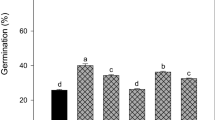Abstract
The percentage and the rate of germination of seeds of three varieties of Florence fennel was higher in the dark than in the light, the high temperature cut-off points being between 27.2 and 29.4°C. The optimum temperature for germination was between 20 and 25°C. Seeds of all three varieties responded to incubation in solutions containing gibberellin A4/7 mixture (GA4/7; ‘Regulex’), giving higher germination in the light at temperatures from 20 to 30°C. Seeds steeped for 4 h at 25°C or for 24 h at 5°C in GA4/7 solutions gave a higher percentage and increased rate of emergence as compared with untreated dry seeds, when sown in compost at 25°C; steeping in water alone was also beneficial. In general, drying the treated seeds before sowing reduced the rate but sometimes increased the percentage of germination as compared with seeds sown when still moist. Seeds harvested from secondary umbels of var. Zefa fino germinated better both in the light and dark than those taken from primary umbels.
Similar content being viewed by others
Abbreviations
- GA4/7 :
-
a commercial mixture of the gibberellins A4 and A7 (trade name ‘Regulex’)
References
Anon (1983) Some minor outdoor vegetables, MAFF leaflet no. 853. pp 9–10
Cavers PB and Harper JL (1966) Germination polymorphism in Rumex crispus and Rumex obtusifolius. J Ecol 54: 367–382
Guy R (1978) Effets de la prégermination sur la germination de 14 epèces agricoles et potagères. Revue Suisse Agric 10: 185–188
Guy R (1980) Quelques example des effets de la temperature sur la germination des plants potagères. Revue Suisse Vitic Arboric Hortic 12: 35–37
Guy R (1981) Influence de la temperature sur la durée de germination des semences de dix epèces potagères. Revue Suisse Vitic Arboric Hortic 13: 219–225
Khan AA (1975) Primary, preventive and permissive roles of hormones in plant systems. Bot Rev 41: 391–420
Thomas TH (1978) Relationship between bolting resistance and seed dormancy of different celery cultivars. Scientia Hortic 9: 311–316
Thomas TH and Biddington NL (1973) Plant hormones — seed germination studies. Ann Rep Nat Veg Res Stn for 1972. pp 57–58
Thomas TH, Biddington NL and O'Toole DF (1979) Relationship between the position on the parent plant and dormancy characteristics of seeds of three cultivars of celery. Physiol Plant 45: 492–496
Thomas TH, Dearman AS and Biddington NL (1986) Evidence for the accumulation of a germination inhibitor during progressive thermo-inhibition of seeds of celery (Apicium graveolens L.). Plant Growth Regul 4: 177–184
Thomas TH, Gray D and Biddington NL (1978) The influence of the position of the seed on the mother plant on seed and seedling performance. Acta Hortic 83: 57–66
Thomas TH, Palevitch D, Biddington NL and Austin RB (1975) Growth regulators and the phytochrome-mediated dormancy of celery seeds. Physiol Plant 35: 101–106
Author information
Authors and Affiliations
Rights and permissions
About this article
Cite this article
Thomas, T.H. Responses of florence fennel (Foeniculum vulgare azoricum) seeds to light, temperature and gibberellin A4/7 . Plant Growth Regul 14, 139–143 (1994). https://doi.org/10.1007/BF00025215
Received:
Accepted:
Issue Date:
DOI: https://doi.org/10.1007/BF00025215




